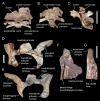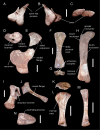A new basal sauropod dinosaur from the middle Jurassic of Niger and the early evolution of sauropoda
- PMID: 19756139
- PMCID: PMC2737122
- DOI: 10.1371/journal.pone.0006924
A new basal sauropod dinosaur from the middle Jurassic of Niger and the early evolution of sauropoda
Abstract
Background: The early evolution of sauropod dinosaurs is poorly understood because of a highly incomplete fossil record. New discoveries of Early and Middle Jurassic sauropods have a great potential to lead to a better understanding of early sauropod evolution and to reevaluate the patterns of sauropod diversification.
Principal findings: A new sauropod from the Middle Jurassic of Niger, Spinophorosaurus nigerensis n. gen. et sp., is the most complete basal sauropod currently known. The taxon shares many anatomical characters with Middle Jurassic East Asian sauropods, while it is strongly dissimilar to Lower and Middle Jurassic South American and Indian forms. A possible explanation for this pattern is a separation of Laurasian and South Gondwanan Middle Jurassic sauropod faunas by geographic barriers. Integration of phylogenetic analyses and paleogeographic data reveals congruence between early sauropod evolution and hypotheses about Jurassic paleoclimate and phytogeography.
Conclusions: Spinophorosaurus demonstrates that many putatively derived characters of Middle Jurassic East Asian sauropods are plesiomorphic for eusauropods, while South Gondwanan eusauropods may represent a specialized line. The anatomy of Spinophorosaurus indicates that key innovations in Jurassic sauropod evolution might have taken place in North Africa, an area close to the equator with summer-wet climate at that time. Jurassic climatic zones and phytogeography possibly controlled early sauropod diversification.
Conflict of interest statement
Figures







References
-
- Sander PM, Clauss M. Sauropod gigantism. Science. 2008;322:200–201. - PubMed
-
- Barrett PM, Upchurch P. Sauropodomorph diversity through time: Macroevolutionary and paleoecological implications. In: Curry Rogers K, Wilson JA, editors. The Sauropods: Evolution and Paleobiology. Berkeley: University of California Press; 2005. pp. 125–156.
-
- Upchurch P, Barrett PM. Phylogenetic and taxic perspectives on sauropod diversity. In: Curry Rogers K, Wilson JA, editors. The Sauropods: Evolution and Paleobiology. Berkeley: University of California Press; 2005. pp. 104–124.
-
- Russell DA. China and the lost worlds of the dinosaurian era. Historical Biology. 1995;10:3–12.
-
- Sereno PC. Tomida Y, Rich TH, Vickers-Rich P, editors. Dinosaurian Biogeography: Vicariance, Dispersal and Regional Extinction. Proceedings of the Second Gondwanan Dinosaur Symposium. 1999. pp. 249–257. Tokio.
Publication types
MeSH terms
LinkOut - more resources
Full Text Sources

